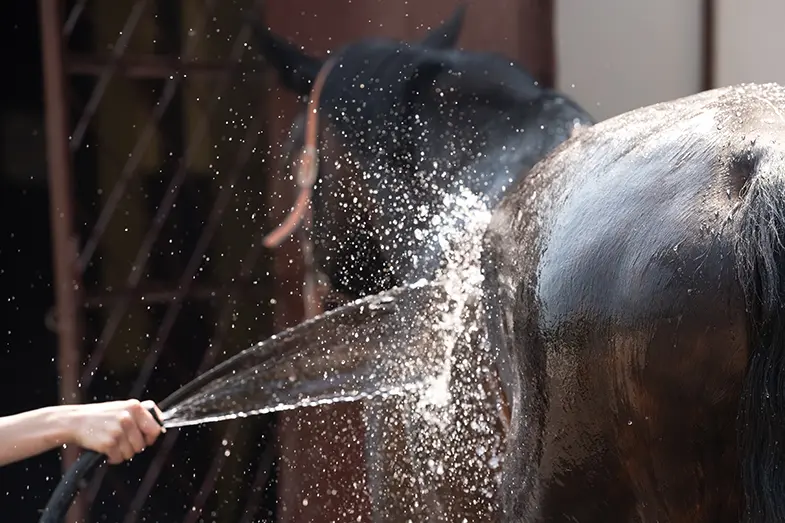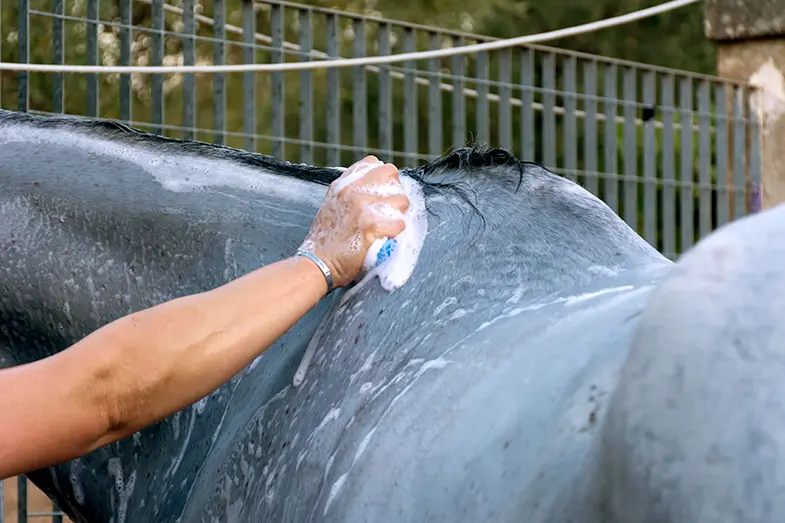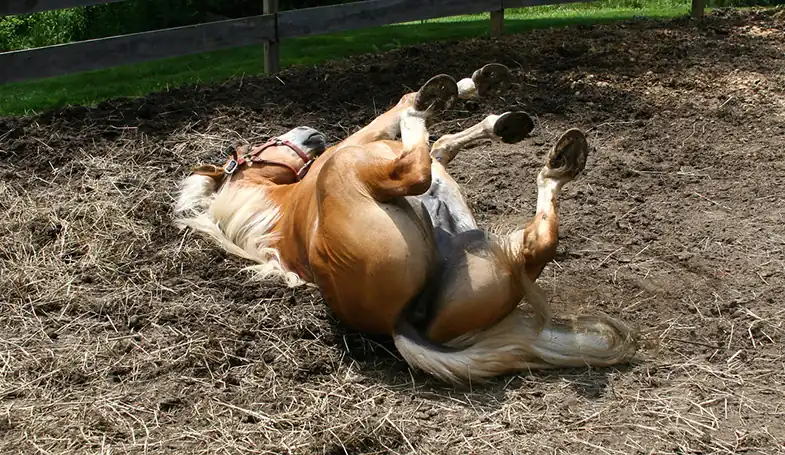We all want our horses to be clean, and washing them is one way to make sure their coats are free of mud, dirt, and sweat but how often should you be washing them? Then there’s the question of how to actually wash your horse, or even whether or not you really need to.
How often should you wash your horse? How often you wash your horse depends largely on how dirty your horse is as well as whether or not you show him. If you do show your horse then he’ll probably need to be washed once a fortnight. Whereas if you don’t show him, and he doesn’t get very muddy, you may never need to wash him.
Everybody has their own way of washing a horse, some will wash them regularly with a hose and shampoo, while others may only spot clean them when they get dirty. The trouble is that this doesn’t really answer the question of how to wash your horse which is why I decided to write this article. My goal was to help answer all of your horse washing questions.
How often is too often to wash your horse?
Most people wash their horses to remove mud, sweat, and even grass stains from them but while this is fine to do (and even a good thing) it shouldn’t be done too often. The reason for this is that washing your horse with shampoo (no matter how mild it is) will remove some of the natural oils from his coat. While these oils will be replaced it can take a few days for this to happen. This means that not only will your horse’s coat lose its shine, but he won’t be able to keep the rain out or keep himself warm, at least until the oils are replaced.
The more natural oils your horse’s coat has the more often you can wash him without removing them. If you’re not sure how much oil your horse has look at the beading on his coat (after you’ve sprayed him with water). If it disappears quickly he doesn’t have much, essentially the longer they take to go the more oil he has.
With this in mind, you should aim to wash your horse no more frequently than every week, although every two weeks is better. If he gets dirty or sweaty in the meantime you can either spot clean him (in the case of mud) or hose him down if he’s sweaty.
While I’ve just said you shouldn’t wash your horse more than once a week, there are some medical conditions, such as rain rot, sweet itch or bacterial infections, or even some injuries that mean you need to wash your horse more often, sometimes even every day. This should only be done with specialist products and if your vet has said you need to do so.
Do you always need to wash your horse?
Just because your horse is dirty doesn’t automatically mean that he needs to be washed, in some cases, you can get away with simply rinsing him or even just spot cleaning the offending areas. The key is to know when to wash, when to rinse and when to spot clean.
It’s also worth mentioning that you can wash your horse’s tail as often as you like without damaging it, although I’d use a mane and tail detangler to help keep it soft and free of knots.
When should you wash your horse? If your horse is covered in mud or you’re just about to go to a show then you will probably find giving him a full-bodied wash is the best option.
When should you rinse your horse? If your horse doesn’t have a lot of natural oil you’ll want to avoid washing him as much as possible. You should also consider rinsing your horse if he’s sweaty, this will also help to cool him down too. The reason that rinsing your horse is okay (and can be done as often as the weather permits) is because it doesn’t strip the oils, it’s the chemicals in the shampoo that remove them.
When should you spot clean your horse? If your horse only has a small amount of mud, sweat, or even a few grass stains, you don’t even need to rinse him. Instead, you can get away with just spot cleaning those areas. To do that you should use a damp, warm cloth on the dirty area, working it in a circular motion will remove any dirt or stains.
Can you wash your horse during the winter?
When a horse’s coat is wet (no matter how thick or long it is) it can get cold very quickly which can make it difficult for them to keep themselves warm and dry. In the summer this isn’t a problem as the temperature is normally higher and there is less chance of them being cold, but in the winter the air is often much colder.
That doesn’t mean to say though that you can’t wash your horse in the winter. If you have a heated wash stall or access to a solarium then you can wash your horse during the winter.
Don’t wash your horse in conditions you wouldn’t choose for yourself
Some horses tend to get very dirty during the winter but you can use a curry comb to remove the dirt (and loose hair) before vacuuming to get rid of the dirt and dust you’ve just removed. If you’re worried about your horse getting really muddy then it’s better to blanket him when the weather’s cold and wet, this will stop him from getting dirty and therefore negate the need for washing him.
What do you need to wash your horse?
There are a lot of different products on the market designed to make it easier to wash your horse, but in reality, there isn’t too much you need. Horse-friendly shampoo, a double-sided rubber squeegee (I find it works far better than a sweat scraper), curry comb or wash mitt, mane & tail comb, sponges, towels, and an adjustable nozzle for the hose is all you need.
You’ll probably only need to buy most of these products once but you will need to top up your shampoo and conditioner from time to time. Over the years I’ve used a huge number of different shampoos but have always found Shapley’s Equitone Color Enhancing shampoos to be the best, they have a huge range of different shampoos for different coat colors. They also have a great tea tree and lemongrass shampoo that’s good for horses with sensitive skin. If your horse is nervous then I’d recommend using Bodhi Dog’s Lavender shampoo, it’s gentle and the lavender will help to keep your horse relaxed.
If you need any of the supplies mentioned you can either click the links below or click here to see the entire list on Amazon. I am an Amazon Affiliate so will make a few cents on every purchase, although it won’t cost you any more.
Shampoos
- Equitone Gold (for palominos, buckskins and gold colors)
- Equitone Red (for chestnuts, sorrels and browns)
- Equitone Black (for blacks, browns and dark bays)
- Equitone White (for white, gray and light colors)
- Medi-Care (for horses with sensitive skin or irritations)
- Hi Shine (gentle and good at leaving a lot of oil in the coat)
- Bodhi Dog’s Lavender shampoo
Everything else
- Mane ’n Tails detangler
- Double sided squeegee
- Rubber curry comb
- Wash mitt
- Mane & tail comb
- Sponges
- Adjustable nozzle
How do you wash a horse?
If you’ve never washed a horse before it can be a little daunting at first but don’t worry it’s pretty straightforward and can even be fun for you both. If your horse doesn’t mind being washed (most horses actually like being washed) then it can also be a great way for the two of you to bond.
When washing your horse you should make sure you’re wearing clothes (and shoes) that you don’t mind getting wet and dirty – believe me, it will happen. It’s also a good idea to have a dry change of clothing too. You should also make sure you have enough time to wash and dry your horse properly, if you rush it your horse will be tense (and so will you) which is never a recipe for success.
Before you start to wash your horse you should make sure he’s tied up securely on a non-slip surface. It’s also a good idea to brush your horse at this stage, it might sound like a waste of time but it’ll get rid of the majority of the dirty and loose hairs and make washing him much easier.
When it comes to actually washing your horse some shampoos work better if they’re mixed with water in a bucket while others are better applied direct to your horse (usually via a wash mitt). Whatever shampoo or method you choose it’s crucial you rinse it all out properly. If you don’t the shampoo will start to dry out and irritate your horse’s skin, making it itchy. Not removing the shampoo will also make your horse’s coat look dull and lifeless.
It’s also important to be methodical and follow a set routine when washing your horse. This will make it easier to know which parts you’ve done but will also help to make the whole process much quicker. Below is the routine I follow when washing any of my horses.
- Use a curry comb to loosen as much dirt from your horse’s coat as possible.
- Gently remove any knots from the mane and tail, you can use a detangler to help with this.
- Use a hose and adjustable nozzle (on the fan setting) to wet your horse, working your way up from his feet.
- Wash your horse in sections (don’t forget to include the mane and the top of the tail), making sure you’ve rinsed all of the shampoo off thoroughly before moving onto the next section.
- Once you’ve washed your horse’s body you can then use a soft sponge to wash their face and delicate areas such as their anus and genitals. Use different sponges for each area and use a clean sponge to rinse them after, don’t use the hose.
- Lastly it’s time to wash your horse’s tail. The best way to do this is by dunking it in a bucket of water before removing it, shaking it and then squeezing the water out. You may need to repeat this a few times to get it really clean.
- After you’ve finished washing your horse you need to remove as much water as possible. You can use a sweat scraper to do this but I find a double side squeegee works best. Whatever you use, work in the same direction as the hair to remove any excess water.
Now that you’re horse is squeaky clean it’s vital to make sure you dry him properly. At best not doing so will make him more likely to roll but at worse can cause serious health problems as he won’t be able to keep himself warm. While a squeegee will get a lot of water out it won’t get all of it so make sure you have a handful of towels to dry your horse further.
If your horse still isn’t completely dry after you’ve finished toweling him there are a few different things you can do to help him dry off completely.
- Solarium – If you have a heated stall or solarium, putting your horse in there will speed up the drying process.
- Walking – If the weather is warm enough you can walk your horse around (letting him graze if he wants to) for around 10 to 15 minutes. This will warm up his muscles and increase his blood flow, both of which will help to finish off the drying.
- Summer sheet – If you need to turn your horse out, or stall him after you’ve washed you should put a lightweight summer sheet on him before doing so. This will help to speed up the final drying stage but will also help to keep him clean if he rolls (which he almost certainly will do at some stage).
How do you wash a horse without water?
If you don’t have access to running water or just don’t want to use any water then you can give your horse a waterless wash instead.
In most cases, you can get away with using a damp towel to spot clean your horse but there are occasions when this just isn’t enough. In these cases, you can use special ‘waterless’ wash products to get your horse’s coat really clean.
There are a few products you can use to do this but I personally like to use Absorbine’s Miracle Groom (Amazon link), or if my horse is a bit smelly I use Shapley’s Easy-Out No Rinse Shampoo (Amazon link). Both are available on Amazon
Related questions
Why does my horse roll as soon as I wash him?
Horses roll for enjoyment but they also do it to remove itches and to make their coat feel normal, which it won’t do after you’ve washed them. They also roll to make themselves smell like a horse again, after all, many horse shampoos have a scent to them that either removes or hides your horse’s natural odor.
Is it okay to wash your horse with cold water?
If you don’t have access to a heated water supply or don’t have electric bucket warmers then you can wash your horse in cold water as long as the weather is warm enough to prevent him from getting a chill.
Further reading
- How to groom your horse like a pro
- Clipping a horse: why, when & how
- Household barn essentials
- 70 amazing life hacks for owners
- Why does my keep horse rolling?
- Preventing sweet Itch in horses
- How to calm a nervous horse
- A beginner’s guide to horse care
I hope you found this article helpful. If you did I’d be grateful if you could share it please as it would really help me.
Recommended products
Over the years I have tried hundreds of different horsey products, from various blankets and halters to different treats. Some I’ve loved, others I’ve hated but I thought I’d share with you my top all-time favorite products, the ones I never leave the yard without. I’ve included links to the products (which are in no particular order) that I really think are great.
- Horse Knots by Reference Ready – If you’re like me and enjoy pocket reference guides then you’ll love this knot tying guide. These handy cards can easily fit in your pocket or attach to the saddle for quick reference. They’re waterproof, durable and are color coded to make them easy to follow.
- Mane ’n Tail Detangler – Even if you never show your horse you’ll need to detangle his tail from time to time (and possibly his mane too) which is always a challenging chore! I’ve found that if I run a little bit of detangler through my horse’s tails every few days it stops them from getting matted up and makes combing them easy, even if they’re coated in mud. I don’t know if I should admit to this or not but it also works wonders on my hair.
- TAKEKIT Pro clippers – Over the years I’ve tried a lot of different clippers and while some were obviously better than others I found these to be by far the best. They are heavier than a lot of other clippers but for me, that’s a good thing, it makes them feel more sturdy and hardwearing. On top of that they have a range of speeds so are just as good for clipping your horse’s back as they are his face. I also like the fact that they come in a handy carry case but that’s not for everybody. The company that makes them is super good and incredibly helpful too, a real bonus these days. The only thing I wasn’t keen on was the fact that it doesn’t come with any oil, but that’s not a major problem as it’s not difficult to buy lubricant.
- Shire’s ball feeder – There are so many boredom buster toys out there but I like to use these every day, regardless of whether or not my horses are bored. I find that it helps to encourage my horses to problem solve by rewarding them with treats (or pieces of fruit) but it also mimics their natural grazing behavior which helps to keep them calm and de-stressed.
- Horse safe mirror – This is a strange one that many people are surprised about but I like to put horse safe mirrors in the trailers as well as in the quarantine stalls. It helps to prevent the feeling of isolation by giving the impression of other horses being around. Being herd animals horses can get extremely stressed when they feel that they’re on their own but with these stick-on mirrors, they believe that at least one other horse is with them.
- Rectal thermometer – I know this isn’t glamourous at all but it’s vital for your horse’s well-being to be able to check their temperature and a rectal thermometer is the easiest way of doing this which is why I’ve added it to the list.
Shopping lists
I’ve also put together a few shopping lists of essential items that I’ve found helpful over the years. I’ve broken the lists down into different categories rather than put everything in one massive list 😉



